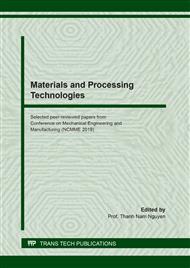p.25
p.33
p.51
p.59
p.67
p.73
p.79
p.85
p.97
Mechanical Properties of PMMA/PC Blend by Injection Molding Process
Abstract:
Polycarbonate (PC) has the high impact strength, whereas Polymethylmethacrylate (PMMA) possesses the high tensile strength. Both of them have been widely used for optical elements in illumination. This paper aims to investigate mechanical properties including tensile and impact strengths of PMMA/PC blend with 50 percent of PC concentration by injection molding process. Tensile and impact specimens were designed following ASTM, type V and were fabricated by injection molding process. Taguchi technique was employed to figure out the optimal process conditions for maximum tensile and impact strengths. The processing conditions such as melt temperature, mold temperature, packing pressure and cooling time were applied and each factor has three levels. As a results, melt temperature has been found to be the most significant parameter for both tensile and impact strengths and cooling time is the least significant parameter for the mechanical properties.
Info:
Periodical:
Pages:
67-71
Citation:
Online since:
September 2020
Authors:
Keywords:
Price:
Сopyright:
© 2020 Trans Tech Publications Ltd. All Rights Reserved
Share:
Citation:


